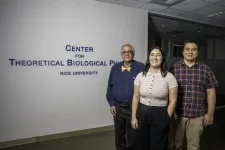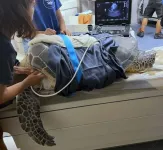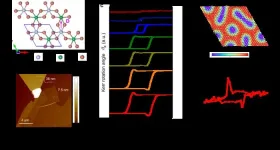(Press-News.org) Texas Tech University’s Biological Threat Research Laboratory (BTRL) played a key role in detecting the first case of highly pathogenic avian influenza (HPAI) A (H5N1) transmitted from a mammal (dairy cow) to a human.
The case was made public in an article published in the New England Journal of Medicine. Steve Presley, the director of The Institute of Environmental and Human Health (TIEHH) and the BTRL, and Cynthia Reinoso Webb, the biological threat coordinator at TIEHH, were co-authors on the journal publication.
The journal article explains that in March a farm worker who reported no contact with sick or dead birds, but who was in contact with dairy cattle, began showing symptoms in the eye and samples were collected by the regional health department to test for potential influenza A.
Initial testing of the samples was performed at the BTRL, which is a component of the Centers for Disease Control and Prevention (CDC) Laboratory Response Network-Biological (LRN-B) located at TIEHH.
“It’s a huge thing that the virus has jumped from birds to mammals, dairy cows in this case, and then to humans,” Presley said. “That’s why this paper in the New England Journal of Medicine is very significant. It’s going to lay the foundation, I believe, for a lot of research in the future of how the virus is evolving.”
The involvement of Texas Tech’s BTRL is a continuation of the partnership between regional, state and federal public health partners.
“Being part of the CDC LRN-B, we have the standing capability to test for a lot of biological threats and some that are considered emergent,” Reinoso Webb explained.
The lab’s standby status allowed Reinoso Webb and the Texas Tech BTRL team to respond quickly to the needs of the regional public health authority. Knowing the potential dangers of the virus, Reinoso Webb pushed the testing into the safest laboratory available, and the team went to work.
Having received the samples in the early evening, results were being reported to regional, state and federal levels within hours. By the next day the samples were on their way to the CDC for further testing and confirmation.
“We were on the phone with the CDC until around midnight discussing different scenarios and follow up requirements,” Reinoso Webb said. “There is a lot of federal reporting. It was a very complicated case, even though it was two samples and one patient.
“But we had this wonderful communication with the CDC and made sure we did everything by the book. This is how it’s been structured, and this is how the communication was supposed to happen.”
END
Texas Tech researchers help confirm first case of avian influenza transmitted from cow to human
2024-05-13
ELSE PRESS RELEASES FROM THIS DATE:
Coming out to a chatbot?
2024-05-13
Today, there are dozens of large language model (LLM) chatbots aimed at mental health care — addressing everything from loneliness among seniors to anxiety and depression in teens.
But the efficacy of these apps is unclear. Even more unclear is how well these apps work in supporting specific, marginalized groups like LGBTQ+ communities.
A team of researchers from the Harvard John A. Paulson School of Engineering and Applied Sciences, Emory University, Vanderbilt University and the University of California Irvine, found that while large language models can offer fast, on-demand support, they frequently fail to grasp the specific challenges that many members ...
Persistent strain of cholera defends itself against forces of change, scientists find
2024-05-13
A deadly strain of cholera bacteria that emerged in Indonesia back in 1961 continues to spread widely to this day, claiming thousands of lives around the world every year, sickening millions — and, with its persistence, baffling scientists. Finally, in a study published today in Nature, researchers from The University of Texas at Austin have discovered how this dangerous strain has held out over decades.
A longstanding mystery about the strain of Vibrio cholerae (V. cholerae) responsible for the seventh global cholera pandemic is how this lineage has managed ...
Rice study reveals insights into protein evolution
2024-05-13
Rice University’s Peter Wolynes and his research team have unveiled a breakthrough in understanding how specific genetic sequences, known as pseudogenes, evolve. Their paper was published May 13 by the Proceedings of the National Academy of Sciences of the United States of America Journal.
Led by Wolynes, the D.R. Bullard-Welch Foundation Professor of Science, professor of chemistry, biosciences and physics and astronomy and co-director of the Center for Theoretical Biological Physics (CTBP), the team focused on deciphering the complex energy landscapes of de-evolved, putative protein sequences corresponding to pseudogenes.
Pseudogenes are ...
Low testosterone in men associated with higher risk for death
2024-05-13
Embargoed for release until 5:00 p.m. ET on Monday 13 May 2024
Annals of Internal Medicine Tip Sheet
@Annalsofim
Below please find summaries of new articles that will be published in the next issue of Annals of Internal Medicine. The summaries are not intended to substitute for the full articles as a source of information. This information is under strict embargo and by taking it into possession, media representatives are committing to the terms of the embargo not ...
Chatbots tell people what they want to hear
2024-05-13
Chatbots share limited information, reinforce ideologies, and, as a result, can lead to more polarized thinking when it comes to controversial issues, according to new Johns Hopkins University–led research.
The study challenges perceptions that chatbots are impartial and provides insight into how using conversational search systems could widen the public divide on hot-button issues and leave people vulnerable to manipulation.
“Because people are reading a summary paragraph generated by AI, they think they’re getting unbiased, fact-based answers,” said lead author Ziang Xiao, an assistant professor of computer ...
Herpes cure with gene editing makes progress in laboratory studies
2024-05-13
SEATTLE — May 13, 2024 — Researchers at Fred Hutch Cancer Center have found in pre-clinical studies that an experimental gene therapy for genital and oral herpes removed 90% or more of the infection and suppressed how much virus can be released from an infected individual, which suggests that the therapy would also reduce the spread of the virus.
“Herpes is very sneaky. It hides out among nerve cells and then reawakens and causes painful skin blisters,” said Keith Jerome, MD, PhD, professor ...
Catch and release can give sea turtles the bends #ASA186
2024-05-13
OTTAWA, Ontario, May 13, 2024 – Six out of seven sea turtle species are endangered, and humans are primarily responsible. Commercial fishing activities are the largest human-caused disturbance to sea turtles due to accidental capture.
Fishers are typically unaware if a sea turtle is caught in their net until it’s completely pulled out of the water. However, releasing sea turtles without veterinary evaluations can be harmful. When accidentally caught, the turtles’ normal diving processes are interrupted, ...
Researchers unveil unique tidal disruption event with unprecedented early optical bump
2024-05-13
A research team from the University of Science and Technology of China (USTC) of the Chinese Academy of Sciences (CAS) presented a detailed analysis of a tidal disruption event (TDE) with unique characteristics, providing new insights into the behavior of TDEs and their multiwavelength emissions. The study was published online in The Astrophysical Journal Letters.
When a star ventures too close to a supermassive black hole at the center of a galaxy, it gets torn apart by the black hole's immense tidal forces, resulting ...
Researchers discover "topological hall effect" in two-dimensional quantum magnets
2024-05-13
In a recent study published in Nature Physics, researchers from the Hefei Institutes of Physical Science of the Chinese Academy of Sciences, together with researchers of University of Science and Technology of China, have introduced the concept of the "Topological Kerr Effect" by using the low-temperature magnetic field microscopy system and the magnetic force microscopy imaging system supported by the steady-state high magnetic field experimental facility.
The study holds great promise for advancing our understanding of topological magnetic ...
Like dad and like mum…all in one plant
2024-05-13
In a new study, led by Charles Underwood from the Max Planck Institute for Plant Breeding Research (MPIPZ) in Cologne, Germany, scientists established a system to generate clonal sex cells in tomato plants and used them to design the genomes of offspring. The fertilization of a clonal egg from one parent by a clonal sperm from another parent led to plants containing the complete genetic information of both parents. The study is now published in Nature Genetics.
Hybrid seeds, combining two different parent lines with specific favorable traits, are popular in agriculture as they give rise to robust crops with enhanced productivity, and have been utilized by farmers ...



